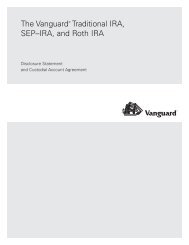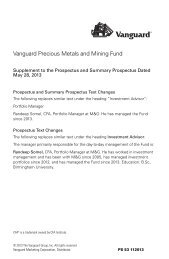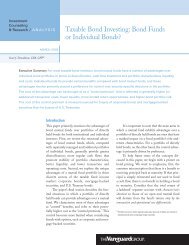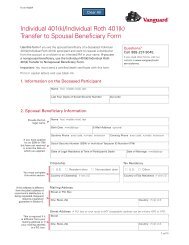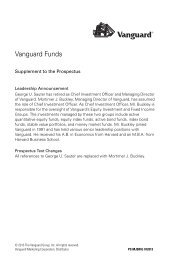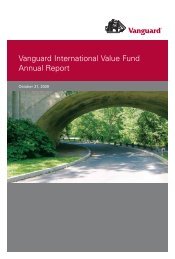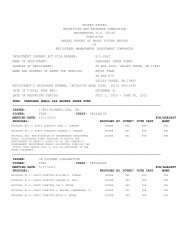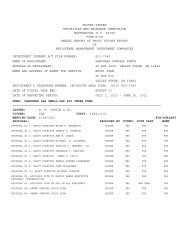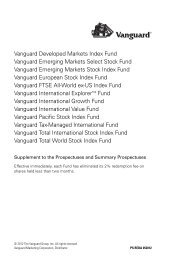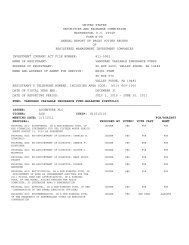Vanguard International Stock Index Funds Annual Report
Vanguard International Stock Index Funds Annual Report
Vanguard International Stock Index Funds Annual Report
Create successful ePaper yourself
Turn your PDF publications into a flip-book with our unique Google optimized e-Paper software.
About Your Fund’s Expenses<br />
As a shareholder of the fund, you incur ongoing costs, which include costs for portfolio management,<br />
administrative services, and shareholder reports (like this one), among others. Operating expenses,<br />
which are deducted from a fund’s gross income, directly reduce the investment return of the fund.<br />
A fund’s expenses are expressed as a percentage of its average net assets. This figure is known as<br />
the expense ratio. The following examples are intended to help you understand the ongoing costs (in<br />
dollars) of investing in your fund and to compare these costs with those of other mutual funds. The<br />
examples are based on an investment of $1,000 made at the beginning of the period shown and held<br />
for the entire period.<br />
The accompanying tables illustrate your fund’s costs in two ways:<br />
• Based on actual fund return. This section helps you to estimate the actual expenses that you paid<br />
over the period. The “Ending Account Value” shown is derived from the fund’s actual return, and the<br />
third column shows the dollar amount that would have been paid by an investor who started with<br />
$1,000 in the fund. You may use the information here, together with the amount you invested, to<br />
estimate the expenses that you paid over the period.<br />
To do so, simply divide your account value by $1,000 (for example, an $8,600 account value divided by<br />
$1,000 = 8.6), then multiply the result by the number given for your fund under the heading “Expenses<br />
Paid During Period.”<br />
• Based on hypothetical 5% yearly return. This section is intended to help you compare your fund’s<br />
costs with those of other mutual funds. It assumes that the fund had a yearly return of 5% before<br />
expenses, but that the expense ratio is unchanged. In this case—because the return used is not the<br />
fund’s actual return—the results do not apply to your investment. The example is useful in making<br />
comparisons because the Securities and Exchange Commission requires all mutual funds to calculate<br />
expenses based on a 5% return. You can assess your fund’s costs by comparing this hypothetical<br />
example with the hypothetical examples that appear in shareholder reports of other funds.<br />
Note that the expenses shown in the table are meant to highlight and help you compare ongoing<br />
costs only and do not reflect transaction costs incurred by the fund for buying and selling securities.<br />
Further, the expenses do not include the transaction fees or the account service fee described in the<br />
prospectus. If such fees were applied to your account, your costs would be higher. Your fund does<br />
not carry a “sales load.”<br />
The calculations assume no shares were bought or sold during the period. Your actual costs may have<br />
been higher or lower, depending on the amount of your investment and the timing of any purchases<br />
or redemptions.<br />
You can find more information about the fund’s expenses, including annual expense ratios, in the<br />
Financial Statements section of this report. For additional information on operating expenses and<br />
other shareholder costs, please refer to your fund’s current prospectus.<br />
95




